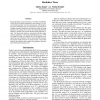Free Online Productivity Tools
i2Speak
i2Symbol
i2OCR
iTex2Img
iWeb2Print
iWeb2Shot
i2Type
iPdf2Split
iPdf2Merge
i2Bopomofo
i2Arabic
i2Style
i2Image
i2PDF
iLatex2Rtf
Sci2ools
AAAI
2008
2008
Backdoor Trees
The surprisingly good performance of modern satisfiability (SAT) solvers is usually explained by the existence of a certain "hidden structure" in real-world instances. We introduce the notion of backdoor trees as an indicator for the presence of a hidden structure. Backdoor trees refine the notion of strong backdoor sets, taking into account the relationship between backdoor variables. We present theoretical and empirical results. Our theoretical results are concerned with the computational complexity of detecting small backdoor trees. With our empirical results we compare the size of backdoor trees against the size of backdoor sets for real-world SAT instances and random 3SAT instances of various density. The results indicate that backdoor trees amplify the properties that have been observed for backdoor sets.
| Added | 02 Oct 2010 |
| Updated | 02 Oct 2010 |
| Type | Conference |
| Year | 2008 |
| Where | AAAI |
| Authors | Marko Samer, Stefan Szeider |
Comments (0)

